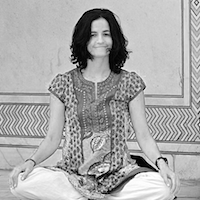I must first confess that I am a beginner herbalist—I’ve just started on this path.
This is a work in progress. More like sharing my scribbles and doodles from a beginners class. It’s a journey, a long one and I’m just starting to pack.
But when finding such a beautiful path, I want to get everyone to walk it with me. I think it’s good for everyone to take a look at herbalism—the tradition of studying nature by observing it is the basis of medicine, Ayurveda and all the sciences, really.
It all started simply and even if we don’t intend to cook our own cough syrup, there is a lot to be gained by learning the tradition of healers.
It’s easy to get curious about plant’s magnificence.
I love planting my feet on the wet earth and connecting more deeply. It is enchanting. And I’ve found enlightened, generous teachers, resources, books, illustrations, apps and plant spirit songs.
Herbalism will make our life richer. It will help us understand the world and ourselves better.
They say we are all just parasites of plants, as the are the only beings that “manufacture their food out of sunshine.” They are food and medicine, poison and hallucinogens. They’re resilient, popping out of concrete cracks. They’re ancient peaceful beings.
Let’s start by setting our roots.
“A precondition is, of course, to live a quiet and observant life. A good conscience and upright life, full of compassion and sympathy for all living beings, is the necessary ground upon which the knowledge of wortcunning can develop.”
~ Wolf Storl in The Herbal Lore of Wise Women and Wortcunners: The Healing Power of Medicinal Plants
Wortcunning refers to the knowledge of roots:
“A root-knower (wortcunner) is a seer. He or she knows the root of the illness that strikes a human being down and knows the root of the cure: the wort, which unfolds as secretly in the dark as the very malaise it will heal.“ “this method easily passes beyond the borders and barriers of the scientific method. It might not get you a doctorate in botany or make you an MD, but it will make you— if the gods be willing— a cunner of worts.“
~Wolf Storl
Steps to set you on your path toward herbalism:
Walk in nature everyday: Mindfully looking at plants, trees, flowers. Go out every season. Even when is cold, rainy or gray. Even when is too hot and the jungle is steaming.
Get to know the plants: Watch for details. Look at them, then close your eyes. Take in their full presence. Smell, texture, color. When your back home try to revisit them with your imagination. Get an illustrated guide so you can identify them. I like Samuel Thayer’s Nature Garden, it’s has in-depth profiles of the plants it covers and many pictures.
Get the App: Taking this ancient art to high technology, there are great tools now. As the Wild Edible app for the iPhone by WildMan Steve Brill that helps identify and use edible plants. And Brigitte Mars who did an awesome Walk the Talk Show on urban foraging has iPlant.
Spice it up: A lot of plants are edible and cooking herbs have strong flavors and perfumes. They’re easily available. By placing special attention on how you are using and mixing common herbs like Basil, Rosemary, Parsley and Mint. How come we think some go well with salty and others with sweets? Try to find you own taste pairings. Try dried or fresh herbs, wild organic or bio. Infuse them, cook and smoke them and try them raw.
Interpret the plants: Ha! this is where it goes off the cliff. But it’s Storl’s recommendation to “draw or, better yet, paint with water colors”. He goes further saying “dance out the gestures of the plant” in order to “become the plant.” In Ayahuasca ceremonies the shamans supposedly get songs directly from the plant spirit, they’re called icaros.
Become aware of your dreams: Dreaming is a different state of consciousness and, as you can probably tell by now, this herbalist business is not only about the science, is connecting a to a deep ancient knowledge that comes from our history as humans and our animal nature.
Inspired decoration: Surround yourself with celebrations of plant spirit. This will probably happen automatically as you become enchanted by plants. You’ll start collecting not only potted plants and flowers in your house, but other artistic finds like “Historic drawings of Yerba Mansa or flowering Mullein, or the voluptuous Victorian images we humorously refer to as “plant porn“ as The Enchanted Healer Jesse Wolf Hardin says in Mother Earth News.
Practice the healing arts: Our intention marks our work. Plants have immense power and this power is there for nurturing and healing. Nature has a presence of quiet intelligence and as we tap into this intelligence it’s subtle purpose becomes clear and we should aligned to this.
I hope you find this information useful, even if only to make you curious. If you venture to try any of this or if you’re already further down this path, please share your experience in the comments. I would love to hear from you.
Love elephant and want to go steady?
Sign up for our (curated) daily and weekly newsletters!
~
~
Author: Ana Guardia
Editor: Ashleigh Hitchcock












Read 5 comments and reply